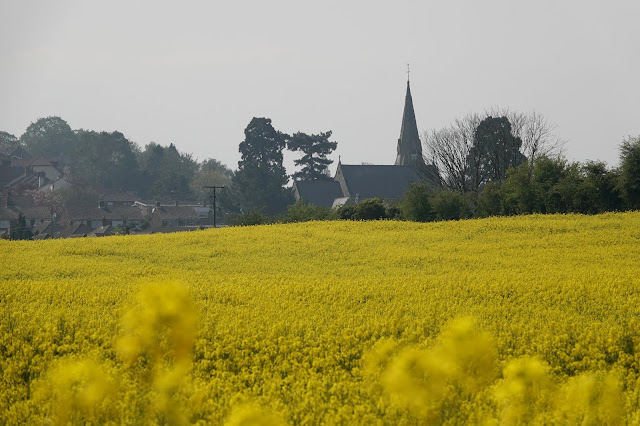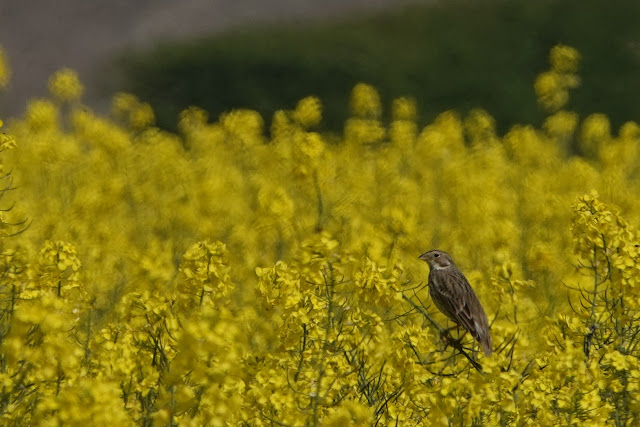I was woken up by the mellifluous sound of a cascading
Willow Warbler singing in my garden which spurred me on to get out early and by
8.30 I was on my way. There was a nip in
the air but it was already sunny and looked like it would turn out nice again.
My route took me up my road and up onto Rede Common once
again. There was no change until I nearly reached the A2 where my second Willow
Warbler of the day was singing in the Oaks.
Whilst listening to that I got distracted by some silvery dewy spider hammocks
in the grass and a few sunbathing Hoverflies on a Blackthorn. Eristalis pertinax and Epistrophe eligans are
certainly the commonest species everywhere I have been in recent weeks and
these were joined by a furry Myathropa florea, Platycheirus scutatus agg and a
nice Dasysyrphus albostriatus.
 |
| Eristalis pertinax |
 |
| Myathropa florea |
 |
| Epistrophe eligans |
 |
| Platycheirus scutatus agg |
 |
| Dasysyrphus albostriatus |
I carried on down the road to Crutches Lane passing drifts
of Dandelions that had already gone to seed since I started these walks and
then got distracted by a superb front garden with a colony of hundreds of
Andrena flavipes swarming around the narrow bank and finely mown lawn. Amongst them were quite a few of their
parasitic companion Nomada fucata.
 |
| Andrena flavipes & Nomada fucata |
 |
| Andrena flavipes & Nomada fucata |
 |
| Andrena flavipes & Nomada fucata |
 |
| Nomada fucata |
A little further along a couple of spindly Hawthorns were
being ravaged by tented Brown-tail Moth caterpillars and I took some pics from
a respectable distance.
 |
| Brown-tail Moth caterpillars |
I went past the entrance to Crabbles Bottom Orchard and
swung into main Great Crabbles Wood about a hundred yards further along. Once I had got past
the fly tipping at the entrance I entered the best piece of coppiced woodland I
have so far visited. Florally it was
much as elsewhere but although the Bluebells were magnificent, they were
tempered by a mosaic of whites and yellows from Anemones and Celandines and
patches of taller robust green from Spurge Laurel, Stinking Iris and Butchers Broom
as well as a delightful lime green grass with airy flowers that was dotted
around in clumps.
 |
| Wood Anemones |
 |
| Bluebells |
 |
| Hazel Stoool |
 |
| Butchers Broom |
 |
| Spurge Laurel |
 |
| Bluebell |
 |
| Lords and Ladies |
 |
| Bee Fly on Ash |
 |
| Guelder Rose |
There were patches of Moschatel growing in the margins and I
found my first Early Purple Orchids in the same spot but trumped that a little
further on with a superb scattered colony within the actual wood around what
looked like a perfectly circular bomb crater. They were the biggest I have ever
seen with some 18 inches tall and they came in all a range of colours from
paleish pink to proper purple. The
leaves were also quite variable with some rounded and spotty, some long and
spotty and some without any marks at all!
 |
| Moschatel |
I poked around in some rot holes for hoverfly larvae (no
joy) but I did find a mass graveyard of these little snails inside one and then
got distracted by some smart black ants called Lasius fuliginosus and a big Red-tailed Bumblebee who was looking
for a nest hole.
 |
| Snail Pit of Despair |
 |
| Lasius fuliginosus |
 |
| Lasius fuliginosus |
 |
| Red-tailed Bumblebee - Bombus lapidarius |
Bullfinches were singing and calling with at least three pairs
I reckon but I never saw one. In fact, thinking about it, I barely saw a bird
the whole time I was in there and a Green Woodpecker and two Nuthatch
territories were all I encountered.
The path swung around and up through a much more mature area
of coppice and the Bluebells were more intensive and intense up here. Peacocks visited them and I found others
basking on trunks with, unsurprisingly Gymnocheta viridis.
 |
| Wood Mellick & Bluebells |
 |
| Peacock |
 |
| Gymnocheta viridis. |
 |
| Pollenia sp. |
 |
| Flesh Fly |
 |
| Anthomyiidae sp |
A fallen log was covered in a lacework of beetle larvae
mines and I discovered a rather bizarre patch of naturalised Gooseberry bushes!
Eventually the path popped out via an alley onto Peartree
Lane in between the huge properties and gardens of Shorne Ridgeway. I followed the road toward Higham adding
three more Nuthatch territories on the way but little else.
 |
| Beetle larvae mines |
 |
| Gooseberry |
 |
| White Bryony |
 |
| Buzzard |
From here I cut around Higham before taking a bridleway out
into the glowing yellow of the oilseed rape fields to the north of the
village. My previous encounter with such
fields had been birdless but to my delight these were not. Skylarks sang all around and I was over the
moon to hear the jangling of a Corn Bunting.
I soon picked him up way out on the Canary coloured sea and soon found
four males between two such giant fields.
A single Yellow Wagtail was heard but not seen and they are
quite keen on this mono-culture habitat so hopefully I will pick them up on
subsequent visits. It is still early in
the season.
 |
| Higham Church |
 |
| Corn Bunting |
 |
| Corn Bunting |
A single male House Sparrow was also singing out in the
fields much in the manner of the Corn Bunting – a most unusual sight. This species appears to be doing just fine in
my part of north Kent and I have encountered them everywhere I have been
whether urban or rural.
 |
| House Sparrow |
Buzzards and Med Gulls circled overhead and a pair of Kestrels were seen although I have yet to
see this species over my house since lockdown where it is far rarer than Hobby
or Peregrine.
I started to turn towards home and made my way back up to Hermitage
Lane to say hello to the horses and the male Swallow I encountered last week
before dropping back down a narrow bridleway to Dillywood and the last road
stretch before lunch.
 |
| Linnet |
 |
| This had me going from a distance |
 |
| Small Tortoiseshell |







































No comments:
Post a Comment